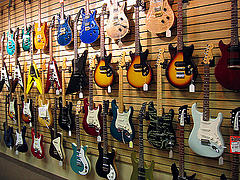Ten Tips for the Guitar Teacher
/ Photo by fictures.Here are a few things I've observed in my years of teaching (and coaching teachers!). If you're new to working with students, you may find some helpful suggestions below. If you're a veteran guitar instructor, you'll have some things to add! Let me know in the comments.
Photo by fictures.Here are a few things I've observed in my years of teaching (and coaching teachers!). If you're new to working with students, you may find some helpful suggestions below. If you're a veteran guitar instructor, you'll have some things to add! Let me know in the comments.
1. Model the behaviors that you want your students to have. If you're a noodler, you'll end up with a roster full of noodlers. If you go straight to the online tabs, that's what your students will do, too. On the other hand, if you display good musical etiquette and resourcefulness, your students will follow suit.
2. Don't be afraid to address technique. A stool is better than a chair. If a student happens to be sitting in a chair, have him sit at the edge of the chair without leaning against the back. Feet should not dangle, so if the guitarist is small you'll need either a low stool or a footrest. Get the left elbow off of the left thigh. The whole point of good technique is to facilitate good playing - in other words, it should make things easier.
3. Don't overdo the theory. Whenever possible, teach music theory in the context of a song or musical piece. "Hey, this song is in Mixolydian mode and here's the scale you'll be using…" is appropriate and relevant. The all-too-common attitude of "here are all the modes even though you'll never ever have a use for half of them," doesn't help. You want your students to see the forest for the trees and actually make music.
4. Printing and photocopying is not a good use of lesson time. Aspiring singer-guitarists should print out the lyrics, typed and double-spaced, to the songs they want to play. Fledgling lead players should bring you tab, whether from a book, online, or created by themselves. Ideally, the students will have already begun learning as much of each song as they can and will be coming to you for the finishing touches.
5. Have appropriate repertoire ready to go. Many students, especially younger ones, will not be prepared with lyrics and lead sheets. In some cases, they won't have any idea what to play. It is a good idea to have a stash of "go-to" lead sheets and books to send home with them.
6. Expect online tabs and chords to be wrong. If you're in the key of F and you're encountering A# chords, that's a clue that the person who posted the tab is not a professional. It's likely that you will find other, more serious mistakes. Make sure you listen to the original recording and make corrections. It's even better if you can explain to your student what you're doing and why.
7. Understand what motivates your student. A ten-year-old Taylor Swift fan will want to strum and sing. The guitar is just the vehicle that delivers the song. She may never be much of a lead player but she may be a songwriter before you know it. On the other hand, if she brings in AC/DC it's probably guitar itself that's attracting her. Riffs and lead patterns are the way to go.
8. Integrate music-reading. If you taught yourself to play guitar at age fifteen, it might be hard to relate to an six-year-old beginner. The fact is, young students need the very structure that teen students often resist. Using a guitar method that teaches note-reading, such as the excellent FJH Young Beginner Guitar Method, is a great way to round out your curriculum and give each student a strong foundation.
9. Finish things. A student might be content to never go further than jamming out while sitting on the end of his bed, but it's still important to complete something. A YouTube video is a great option for a hesitant performer. Playing with others is another great, relatively low-risk way to go from "I take guitar lessons" to "I'm a guitarist."
10. Empower your students. As young guitarists many of us played along with records, figured songs out by ear, created our own tabs, taught ourselves to write songs and formed our own bands. Nudge your students out of the nest and push them to use what they know.
